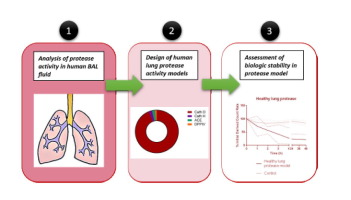当前位置:
X-MOL 学术
›
Eur. J. Pharm. Biopharm.
›
论文详情
Our official English website, www.x-mol.net, welcomes your
feedback! (Note: you will need to create a separate account there.)
Development of new in vitro models of lung protease activity for investigating stability of inhaled biological therapies and drug delivery systems.
European Journal of Pharmaceutics and Biopharmaceutics ( IF 4.4 ) Pub Date : 2019-11-20 , DOI: 10.1016/j.ejpb.2019.11.005 Arcadia Woods 1 , Teodora Andrian 1 , Gemma Sharp 1 , Elif Melis Bicer 2 , Kalliopi-Kelli A Vandera 1 , Ayasha Patel 1 , Ian Mudway 3 , Lea Ann Dailey 4 , Ben Forbes 1
European Journal of Pharmaceutics and Biopharmaceutics ( IF 4.4 ) Pub Date : 2019-11-20 , DOI: 10.1016/j.ejpb.2019.11.005 Arcadia Woods 1 , Teodora Andrian 1 , Gemma Sharp 1 , Elif Melis Bicer 2 , Kalliopi-Kelli A Vandera 1 , Ayasha Patel 1 , Ian Mudway 3 , Lea Ann Dailey 4 , Ben Forbes 1
Affiliation

|
Proteases play a vital role in lung health and are critically important to the metabolic clearance of inhaled protein-based therapeutics after inhalation. Surprisingly little is known about lung fluid protease composition and there is a consequent lack of biorelevant experimental models, which limits research and development in the burgeoning field of inhaled biologics. The aim of this study was to quantify proteases in human lung fluid and to use this data to design novel in vitro experimental models of lung lining fluid possessing biorelevant lung protease activity for use in biopharmaceutical stability studies. As a proof of concept, these novel models were used to investigate the effect of proteolytic activity on the stability of albumin nanoparticles, a biologic nanoparticle formulation widely investigated as a pulmonary drug delivery system. Bronchoalveolar lavage fluid was collected from healthy human volunteers and proteomic analysis was used to quantify the predominant proteases. Based on these data, four new lung protease models were constructed based on: (i) trypsin as a sole protease, (ii) dipeptidyl peptidase IV, cathepsin D, cathepsin H, and angiotensin converting enzyme in ratio and concentration to mimic the protease concentration in healthy lungs. Neutrophil elastase was used to model protease activity in inflammation. Albumin nanoparticles of 100 nm diameter remained intact over 48 h in phosphate buffered saline, but were degraded more rapidly in trypsin (50% reduction in 10 min) compared to the healthy lung protease model (50% reduction in 150 min). The addition of neutrophil elastase to the healthy lung protease model resulted in a similar, but more variable degradation profile. Nanoparticle degradation was associated with concomitant appearance of small fragments and aggregates. In conclusion, we have characterised the protease concentration in the lungs of healthy humans, designed models of lung protease activity and demonstrated their utility in studying albumin nanoparticle degradation. These methods and models have wide application to study the influence of proteases in lung disease, expression of proteases in respiratory cell culture models, stability of peptide and protein-based drugs and inhaled drug delivery systems.
中文翻译:

开发新的肺蛋白酶活性体外模型,用于研究吸入生物疗法和药物输送系统的稳定性。
蛋白酶在肺部健康中起着至关重要的作用,并且对于吸入后基于蛋白质的治疗剂的代谢清除至关重要。令人惊讶的是,人们对肺液蛋白酶的成分知之甚少,因此缺乏生物相关的实验模型,这限制了吸入生物制剂新兴领域的研究和开发。本研究的目的是量化人肺液中的蛋白酶,并利用这些数据设计具有生物相关肺蛋白酶活性的肺内膜液的新型体外实验模型,用于生物药物稳定性研究。作为概念验证,这些新模型用于研究蛋白水解活性对白蛋白纳米颗粒稳定性的影响,白蛋白纳米颗粒是一种作为肺部给药系统被广泛研究的生物纳米颗粒制剂。从健康的人类志愿者中收集支气管肺泡灌洗液,并使用蛋白质组学分析来量化主要的蛋白酶。基于这些数据,构建了四种新的肺蛋白酶模型:(i) 胰蛋白酶作为唯一的蛋白酶,(ii) 二肽基肽酶 IV、组织蛋白酶 D、组织蛋白酶 H 和血管紧张素转化酶的比例和浓度以模拟蛋白酶浓度在健康的肺部。中性粒细胞弹性蛋白酶用于模拟炎症中的蛋白酶活性。与健康肺蛋白酶模型(150 分钟内减少 50%)相比,直径 100 nm 的白蛋白纳米颗粒在磷酸盐缓冲盐水中保持完整超过 48 小时,但在胰蛋白酶中降解更快(10 分钟内减少 50%)。将中性粒细胞弹性蛋白酶添加到健康的肺蛋白酶模型中会产生类似的结果,但更多变的退化曲线。纳米颗粒降解与伴随出现的小碎片和聚集体有关。总之,我们已经表征了健康人肺中的蛋白酶浓度,设计了肺蛋白酶活性模型,并证明了它们在研究白蛋白纳米颗粒降解方面的实用性。这些方法和模型广泛应用于研究蛋白酶对肺部疾病的影响、蛋白酶在呼吸道细胞培养模型中的表达、肽和蛋白质类药物的稳定性以及吸入给药系统。设计了肺蛋白酶活性模型,并证明了它们在研究白蛋白纳米颗粒降解方面的实用性。这些方法和模型广泛应用于研究蛋白酶对肺部疾病的影响、蛋白酶在呼吸道细胞培养模型中的表达、肽和蛋白质类药物的稳定性以及吸入给药系统。设计了肺蛋白酶活性模型,并证明了它们在研究白蛋白纳米颗粒降解方面的实用性。这些方法和模型广泛应用于研究蛋白酶对肺部疾病的影响、蛋白酶在呼吸道细胞培养模型中的表达、肽和蛋白质类药物的稳定性以及吸入给药系统。
更新日期:2019-11-20
中文翻译:

开发新的肺蛋白酶活性体外模型,用于研究吸入生物疗法和药物输送系统的稳定性。
蛋白酶在肺部健康中起着至关重要的作用,并且对于吸入后基于蛋白质的治疗剂的代谢清除至关重要。令人惊讶的是,人们对肺液蛋白酶的成分知之甚少,因此缺乏生物相关的实验模型,这限制了吸入生物制剂新兴领域的研究和开发。本研究的目的是量化人肺液中的蛋白酶,并利用这些数据设计具有生物相关肺蛋白酶活性的肺内膜液的新型体外实验模型,用于生物药物稳定性研究。作为概念验证,这些新模型用于研究蛋白水解活性对白蛋白纳米颗粒稳定性的影响,白蛋白纳米颗粒是一种作为肺部给药系统被广泛研究的生物纳米颗粒制剂。从健康的人类志愿者中收集支气管肺泡灌洗液,并使用蛋白质组学分析来量化主要的蛋白酶。基于这些数据,构建了四种新的肺蛋白酶模型:(i) 胰蛋白酶作为唯一的蛋白酶,(ii) 二肽基肽酶 IV、组织蛋白酶 D、组织蛋白酶 H 和血管紧张素转化酶的比例和浓度以模拟蛋白酶浓度在健康的肺部。中性粒细胞弹性蛋白酶用于模拟炎症中的蛋白酶活性。与健康肺蛋白酶模型(150 分钟内减少 50%)相比,直径 100 nm 的白蛋白纳米颗粒在磷酸盐缓冲盐水中保持完整超过 48 小时,但在胰蛋白酶中降解更快(10 分钟内减少 50%)。将中性粒细胞弹性蛋白酶添加到健康的肺蛋白酶模型中会产生类似的结果,但更多变的退化曲线。纳米颗粒降解与伴随出现的小碎片和聚集体有关。总之,我们已经表征了健康人肺中的蛋白酶浓度,设计了肺蛋白酶活性模型,并证明了它们在研究白蛋白纳米颗粒降解方面的实用性。这些方法和模型广泛应用于研究蛋白酶对肺部疾病的影响、蛋白酶在呼吸道细胞培养模型中的表达、肽和蛋白质类药物的稳定性以及吸入给药系统。设计了肺蛋白酶活性模型,并证明了它们在研究白蛋白纳米颗粒降解方面的实用性。这些方法和模型广泛应用于研究蛋白酶对肺部疾病的影响、蛋白酶在呼吸道细胞培养模型中的表达、肽和蛋白质类药物的稳定性以及吸入给药系统。设计了肺蛋白酶活性模型,并证明了它们在研究白蛋白纳米颗粒降解方面的实用性。这些方法和模型广泛应用于研究蛋白酶对肺部疾病的影响、蛋白酶在呼吸道细胞培养模型中的表达、肽和蛋白质类药物的稳定性以及吸入给药系统。











































 京公网安备 11010802027423号
京公网安备 11010802027423号